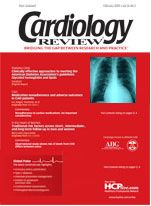Publication
Article
Cardiology Review® Online
Yes, we can prevent coronary heart disease in women
Although cancer recently passed heart disease as the primary cause
of death in Americans, the impact
of preventing a disease responsible for 500,000 deaths a year in women would be enormous. In this review, Hong and Friedman (page 14) nicely review the epidemiological and clinical trial data on this topic.
What is special about women? What is not special is that both women and men have similar risk factors: dyslipidemia, hypertension, diabetes, and cigarette smoking. Treatment of hypertension mark-edly reduces cardiac events. As is found in men, prevalence of hypertension increases with age.
Clinical trial data demonstrating beneficial effects of tighter glucose control on cardiac events are not currently available. Thus, microvascular disease, which is clearly reduced by better glucose control, appears to be more sensitive than atherosclerosis to diabetic treatment. It is likely that longer term trials and more vigorous glucose control are needed to affect cardiac events in diabetic subjects. Large trials, such as Action to Control Cardiovascular Risk in Diabetes, are under way and will include large numbers of women. Diabetes might have a greater impact on risk in women, such that men and women with diabetes have similar rates of cardiac events. Because younger women have lower cardiac event rates than men, it appears that diabetes is more toxic in women.
Differences in lipoprotein profiles have been suggested as the reason for the lower coronary risk in young women. High-density lipoprotein (HDL) cholesterol levels are higher in women and this increase continues through menopause. The reasons for this have been extensively studied. Estrogen reduces the expression of hepatic lipase, an enzyme involved in HDL catabolism. Estrogen therapy also induces greater hepatic production of apoAI, the major apoprotein in HDL.
Low-density lipoprotein (LDL) cholesterol rises in men as they age, and this increase begins as early as the fourth decade of life. It is hard to show that this is associated with deterioration in the intake of heart-healthy diets, however. My experience, both personal and professional, is that teenagers eat the worst diets in America. Unfortunately, young adulthood, beginning in the late twenties, brings with it weight gain and decreased physical exercise. In contrast, women who also experience weight gain during this period do not have LDL increases until after menopause.
As reviewed in this article, data demonstrating the effectiveness of HMG-CoA reductase inhibitor (statin)-induced cholesterol reduction on cardiac disease for women are less robust than for men. As with all cholesterol reduction trials, studies in high-risk women, such as those with diabetes or established heart disease, show the most convincing results. For the clinician there is no issue: all women with coronary heart disease or diabetes need cholesterol reduction unless they already have very low LDL levels. What LDL levels require statin therapy in women? Just as important, which women can avoid or delay cholesterol-lowering therapy? For this, the Framingham risk profile helps immensely in making therapeutic decisions.
